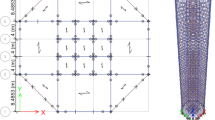Abstract
When assessing the roof of existing buildings, engineers may be confronted with structural joints badly preserved, for instance the damaged Single Step Joint (SSJ) located at the foot of timber trusses. Since the early appearance of failure modes in this traditional carpentry connection may lead to the collapse of the whole timber truss, the retrofitting of damaged SSJ is then required as an economically-viable intervention to stabilize the roof structure. In consequence, the retrofitting of damaged SSJ with Self-Tapping Screws (STS) has been conducted through the Experimental Campaign in order to explore further different possibilities offered by this recent intervention technique (Sobra et al. in Historical earthquake-resistant timber framing in the mediterranean area, pp 359–369, 2016). To this end, two strategies, noted R1 and R2, have been proposed to retrofit the SSJ specimens with STS, which had been previously damaged due to both failure modes, namely the crushing at the front-notch surface and the shear crack in the tie beam (Verbist et al. in Mater Struct, 2017. https://doi.org/10.1617/s11527-017-1028-4). Afterwards, the SSJ specimens retrofitted with STS have been tested under monotonic compression in the rafter in order to pull out their mechanical behaviour encompassing the failure modes, the force–displacement response, the stiffness of the connection, and the ultimate normal force in the rafter. By comparing the mechanical behaviour of retrofitted SSJ specimens with the initial ones from Verbist et al. (2017), the performances of both retrofitting strategies with STS have been discussed. Furthermore, the impact of the shear row splitting on the mechanical behaviour of retrofitted SSJ has been evaluated, by providing some warnings to engineers when intervening in existing timber trusses featuring natural damage such as the shrinkage splitting.












Similar content being viewed by others
References
Valentin J-L (2009) La charpente, mode d’emploi – Chantiers pratiques. Edition Eyrolles, deuxième tirage
Yeomans D (2003) The repair of historic timber structures. Thomas Telford Ltd, London
Shupe T, Lebow S, Ring D (2008) Causes and control of wood decay, degradation and stain. LSU AgCenter—Research & Extension. Louisiana State University Agriculture Center, Baton Rouge, LA. Publication 2703. https://www.fpl.fs.fed.us/documnts/pdf2008/fpl_2008_shupe001.pdf. Accessed 2 Aug 2017
Teles CDM, Do Valle A (2001) Wood structures: acting before deterioration. In: Lourenço PB, Roca P (eds) Historical constructions. University of Minho, Guimarães, pp 857–866
Verbist M, Branco JM, Poletti E, Descamps T, Lourenço P (2017) Single Step Joint: overview of European standardized approaches and experimentations. Mater Struct. https://doi.org/10.1617/s11527-017-1028-4
Branco JM, Descamps T (2015) Analysis and strengthening of carpentry joints. Constr Build Mater 97:34–47 (Special Issue: Reinforcement of Timber Structures)
Tampone G, Ruggieri N (2016) State-of-the-art technology on conservation of ancient roofs with timber structure. J Cult Herit 22:1019–1027
Descamps T, Avez C, Carpentier O, Antczak E, Jeong GY (2016) Historic timber roofs modelling: prosthesis and resin repairs. J Herit Conserv 47:52–60
Parisi MA, Piazza M (2000) Mechanics of plain and retrofitted traditional timber connections. J Struct Eng ASCE 126(12):1395–1403
Croatto G, Turrini U (2014) Restoration of historical timber structures. In: Lourenço PB, Branco JM, Sousa HS (eds) Criteria, innovative solutions and case studies. Seminário Intervir em Construções Existentes de Madeira, Universidade do Minho, Guimarães, pp 119–136
Görlacher R, Kromer M (1991) Tragfähigkeit von Versatzanschlüssen in historischen Holzkonstruktionen. Bruderverlag, Karlsruhe. Edited by Bauen Mit Holz
Munafò P, Stazi F, Tassi C, Davi F (2015) Experimentation on historic timber trusses to identify repair techniques compliant with the original structural-constructive conception. Constr Build Mater 87:54–66
Sobra K, de Rijk R, Aktas YD, Avez C, Burawska I, Branco JM (2016) Experimental and analytical assessment of the capacity of traditional single notch joints and impact of retrofitting by self-tapping screws. In: Historical earthquake-resistant timber framing in the mediterranean area, pp 359–369
Blass HJ, Bejtka I (2002) Joints with inclined screws. International Council for research and Innovation in Building and Construction. Working Commission W18, Timber Structures, CIB-W 18/35-7-5—Kyoto, Japan, September 2002
Bléron L, Lathuillière D, Descamps T, Bocquet J-F (2015) In: Harte A, Dietsch P (eds) Reinforcement of connections with dowel-type fasteners. Reinforcement of Timber Structures, A state-of-art report. Shaker Verlag, Aachen
Dietsch P, Reinhard B (2015) In: Harte A, Dietsch P (eds) Reinforcement with self-tapping screws and threaded rods. Reinforcement of timber structures, A state-of-art report. Shaker Verlag, Aachen
Tomasi R, Crosatti A, Piazza M (2010) Theoretical and experimental analysis of timber-to-timber joints connected with inclined screws. Constr Build Mater 24:1560–1571
ETA-11/0030, European Technical Approval (2012). Self-tapping screws for use in timber structures. EOTA (European Organization for Technical Approval). Rotho Blaas Self-tapping Screws
Eurocode 5, NBN EN 1995-1-1 (2004) Design of timber structures. Part 1‐1: General. Common rules and rules for buildings. CEN, European Standardization Institute, Brussels, Belgium
Uibel T, Blass HJ (2010) A new method to determine suitable spacings and distances for self-tapping screws. In: International council for research and innovation in building and construction—working commission W18, Timber Structures. New Zealand
Acknowledgements
This work was financed by FEDER funds through the Competitively Factors Operational Programme—COMPETE and by national funds through FCT—Foundation for Science and Technology within the scope of the research projects INVISIBLE WOODS PTDC/EPH-PAT/2401/2014, PROTIMBER PTDC/ECM-EST/1072/2014, and the PhD Scholarships SFRH/BD/128580/2017.
Author information
Authors and Affiliations
Corresponding author
Rights and permissions
About this article
Cite this article
Verbist, M., Branco, J.M., Poletti, E. et al. Experimentations on the retrofitting of damaged Single Step Joints with Self-Tapping Screws. Mater Struct 51, 106 (2018). https://doi.org/10.1617/s11527-018-1234-8
Received:
Accepted:
Published:
DOI: https://doi.org/10.1617/s11527-018-1234-8




